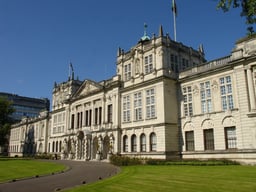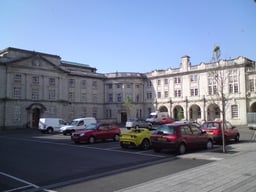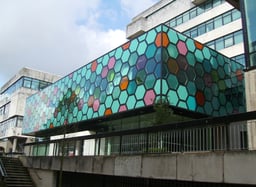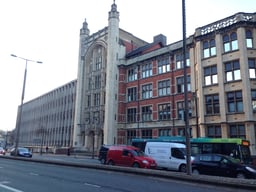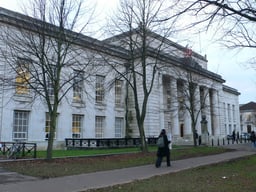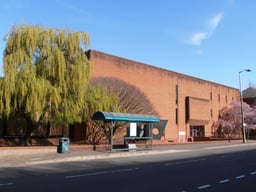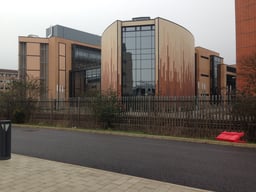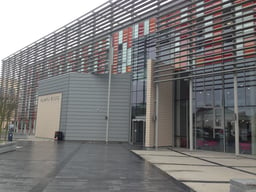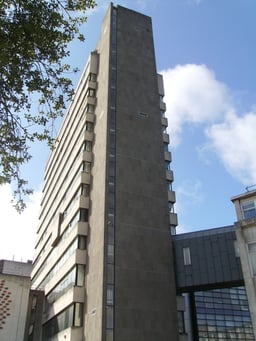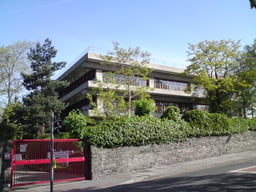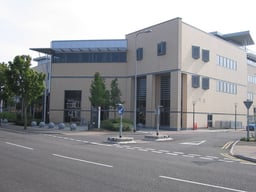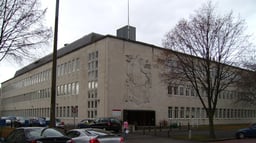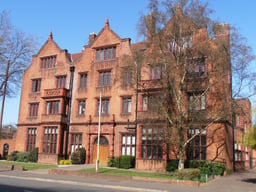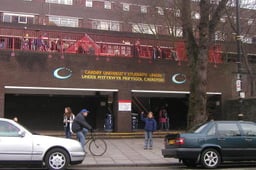Cardiff University
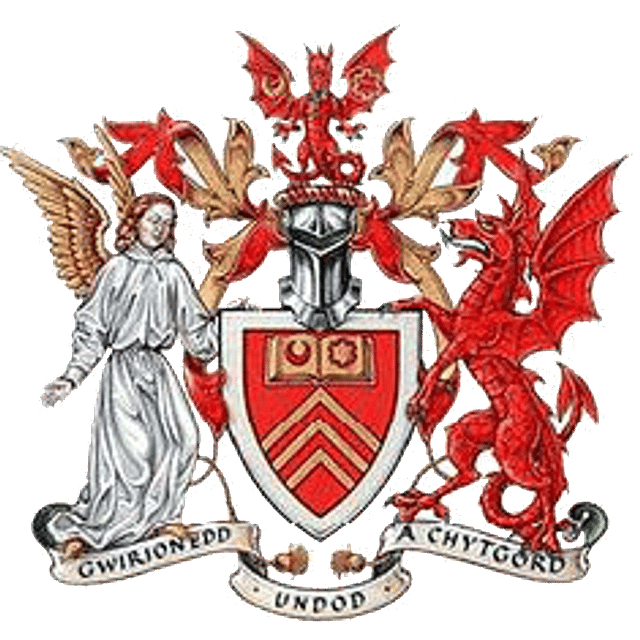
Cardiff University

| Motto | Welsh:Gwirionedd, Undod A Chytgord[2] |
|---|---|
| Truth, Unity and Concord[2] | |
| Type | Public |
| Established | 1883 (/)2005 (independent university) |
| Endowment | £34.5 million[3] |
| Budget | £516.1 million[3] |
| Chancellor | Jenny Randerson[4] |
| Colin Riordan | |
| 5,230 | |
| Students | 31,595 (2016/17)[5] |
| Undergraduates | 23,085 (2016/17)[5] |
| Postgraduates | 8,510 (2016/17)[5] |
| Location | |
| Campus | Urban |
| Colours | |
| Affiliations | Russell GroupEUAUniversities UKGW4 |
| Website | cardiff.ac.uk[98] |
| National rankings | |
| Complete(2020)[11] | 26 |
| Guardian(2020)[53] | 38 |
| Times / Sunday Times(2020)[54] | 32 |
| Global rankings | |
| ARWU(2018)[55] | 101–150 |
| CWTS Leiden(2019)[10] | 129 |
| QS(2020)[56] | 145 |
| THE(2020)[57] | 187= |
| British Government assessment | |
| Teaching Excellence Framework[58] | Silver |
Cardiff University (Welsh: Prifysgol Caerdydd) is a public research university in Cardiff, Wales. Founded in 1883 as the University College of South Wales and Monmouthshire, it became a founding college of the University of Wales in 1893, and in 1997 received its own degree-awarding powers, although it held them in abeyance. It merged with the University of Wales Institute of Science and Technology (UWIST) in 1988. The college adopted the public name of Cardiff University in 1999; in 2005 this became its legal name, as an independent university awarding its own degrees. The third oldest university institution in Wales, it contains three colleges: Arts, Humanities and Social Sciences; Biomedical and Life Sciences; and Physical Sciences and Engineering.
| Motto | Welsh:Gwirionedd, Undod A Chytgord[2] |
|---|---|
| Truth, Unity and Concord[2] | |
| Type | Public |
| Established | 1883 (/)2005 (independent university) |
| Endowment | £34.5 million[3] |
| Budget | £516.1 million[3] |
| Chancellor | Jenny Randerson[4] |
| Colin Riordan | |
| 5,230 | |
| Students | 31,595 (2016/17)[5] |
| Undergraduates | 23,085 (2016/17)[5] |
| Postgraduates | 8,510 (2016/17)[5] |
| Location | |
| Campus | Urban |
| Colours | |
| Affiliations | Russell GroupEUAUniversities UKGW4 |
| Website | cardiff.ac.uk[98] |
| National rankings | |
| Complete(2020)[11] | 26 |
| Guardian(2020)[53] | 38 |
| Times / Sunday Times(2020)[54] | 32 |
| Global rankings | |
| ARWU(2018)[55] | 101–150 |
| CWTS Leiden(2019)[10] | 129 |
| QS(2020)[56] | 145 |
| THE(2020)[57] | 187= |
| British Government assessment | |
| Teaching Excellence Framework[58] | Silver |
Status
Cardiff is the only Welsh member of the Russell Group of research-intensive British universities.[6] It is recognised as providing high-quality, research-based university education, and placed between 100th and 200th in the world by the four major international rankings,[7][8][9][10] and in the top 40 in all three UK achievement tables.[11][12] It ranked 5th in the UK among multi-faculty institutions for the quality (GPA) of its research[13] and 17th for its Research Power in the 2014 Research Excellence Framework.[14] For 2017–2018, Cardiff had a turnover of £516.1 million, including £106.0 million in research grants and contracts.[3]
The university has an undergraduate enrolment of 23,085 and a total enrolment of 31,595 (according to HESA data for 2016/17)[5] making it one of the ten largest universities in the UK. The Cardiff University Students' Union works to promote the interests of the student body within the University and further afield. The university's sports teams compete in the British Universities and Colleges Sport (BUCS) leagues.
History
University College
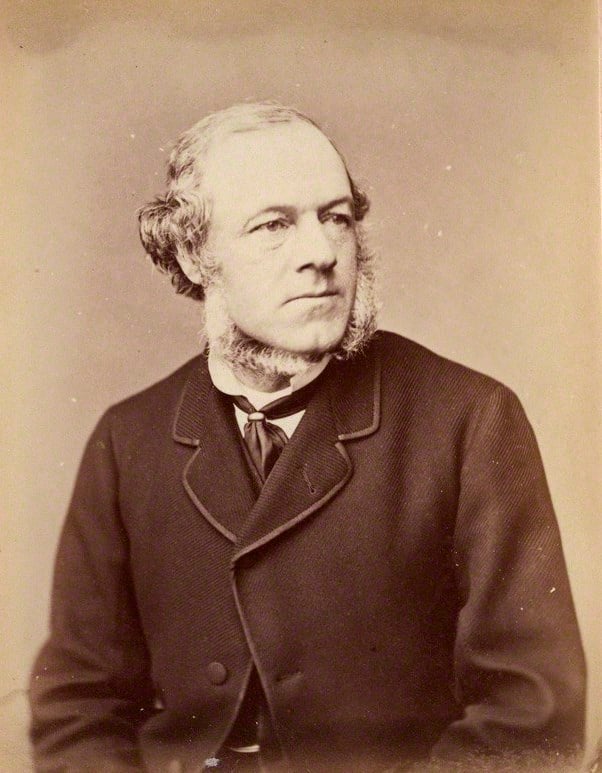
Lord Aberdare was instrumental in the University's founding.
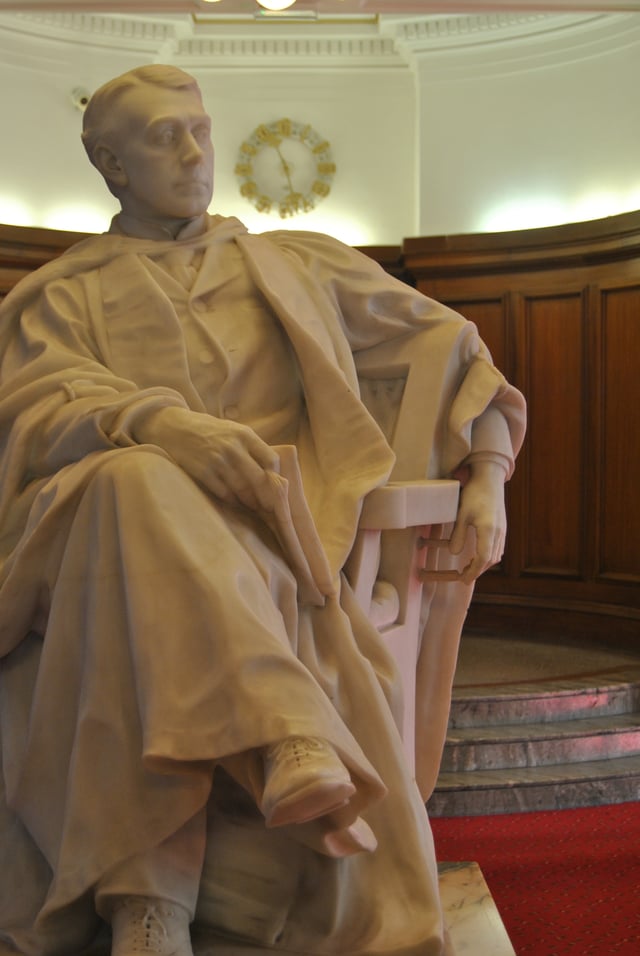
John Viriamu Jones was the founding Principal of the College.
Discussions on the founding of a university college in South Wales began in 1879, when a group of Welsh and English MPs urged the government to consider the poor provision of higher and intermediate education in Wales and "the best means of assisting any local effort which may be made for supplying such deficiency."[15]
In October 1881, William Gladstone's government appointed a departmental committee to conduct "an enquiry into the nature and extent of intermediate and higher education in Wales", chaired by Lord Aberdare and consisting of Viscount Emlyn, Reverend Prebendary H. G. Robinson, Henry Richard, John Rhys and Lewis Morris.[16] The Aberdare Report, as it came to be known, took evidence from a wide range of sources and over 250 witnesses and recommended a college each for North Wales and South Wales, the latter to be located in Glamorgan and the former to be the established University College of Wales in Aberystwyth (now Aberystwyth University). The committee cited the unique Welsh national identity and noted that many students in Wales could not afford to travel to University in England or Scotland. It advocated a national degree-awarding university for Wales, composed of regional colleges, which should be non-sectarian in nature and exclude the teaching of theology.[16][18]
After the recommendation was published, Cardiff Corporation sought to secure the location of the college in Cardiff, and on 12 December 1881 formed a University College Committee to aid the matter.[19] There was competition to be the site between Swansea and Cardiff. On 12 March 1883, after arbitration, a decision was made in Cardiff's favour.[19] This was strengthened by the need to consider the interests of Monmouthshire, at that time not legally incorporated into Wales, and the greater sum received by Cardiff in support of the college, through a public appeal that raised £37,000 and a number of private donations, notably from the Lord Bute and Lord Windsor.[20][21] In April Lord Aberdare was appointed as the College's first president.[19] The possible locations considered included Cardiff Arms Park, Cathedral Road, and Moria Terrace, Roath, before the site of the Old Royal Infirmary buildings on Newport Road was chosen.[19]
The University College of South Wales and Monmouthshire opened on 24 October 1883 with courses in Biology, Chemistry, English, French, German, Greek, History, Latin, Mathematics and Astronomy, Music, Welsh, Logic and Philosophy, and Physics. It was incorporated by Royal Charter the following year, this being the first in Wales to allow the enrolment of women, and specifically forbidding religious tests for entry.[21] John Viriamu Jones was appointed as the University's first Principal at the age of 27. As Cardiff was not an independent university and could not award its own degrees, it prepared its students for examinations of the University of London or for further study at Oxford or Cambridge.[22]
In 1888 the University College at Cardiff and that of North Wales (now Bangor University) proposed to the University College Wales at Aberystwyth joint action to gain a university charter for Wales, modelled on that of Victoria University, a confederation of new universities in Northern England. Such a charter was granted to the new University of Wales in 1893, allowing the colleges to award degrees as members. The Chancellor was set ex officio as the Prince of Wales, and the position of operational head would rotate among heads of the colleges.[21]
In 1885, Aberdare Hall opened as the first hall of residence, allowing women access to the university. This moved to its current site in 1895, but remains a single-sex hall. In 1904 came the appointment of the first female associate professor in the UK, Millicent Mackenzie, who in 1910 became the first female full professor at a fully chartered UK university.
In 1901 Principal Jones persuaded Cardiff Corporation to give the college a five-acre site in Cathays Park (instead of selling it as they would have done otherwise).[23] Soon after, in 1905, work on a new building commenced under the architect W. D. Caröe. Money ran short for the project, however. Although the side-wings were completed in the 1960s, the planned Great Hall has never been built. Caroe sought to combine the charm and elegance of his former (Trinity College, Cambridge) with the picturesque balance of many Oxford colleges. On 14 October 1909 the "New College" building in Cathays Park (now Main Building) was opened in a ceremony involving a procession from the "Old College" in Newport Road.[24]
In 1931, the School of Medicine, founded as part of the college in 1893 along with the Departments of Anatomy, Physiology, Pathology, Pharmacology, was split off to form the Welsh National School of Medicine, which was renamed in 1984 the University of Wales College of Medicine.
In 1972, the institution was renamed University College Cardiff.[25]
1988 merger
In 1988, University College Cardiff underwent financial difficulties, and a declaration of insolvency was considered.[26] This led to a merger with the University of Wales Institute of Science and Technology (UWIST), to form the University of Wales College of Cardiff. The Principal of the new institution was Sir Aubrey Trotman-Dickenson, who had been the principal of UWIST. After changes to the constitution in 1996, its name was changed to the University of Wales, Cardiff.
In the early 1990s, the university's computer systems served as the home for The Internet Movie Database.[27]
Independence and 2004 merger

Queen Elizabeth II with Anthony J. Moses during her visit in Cardiff University in 2000
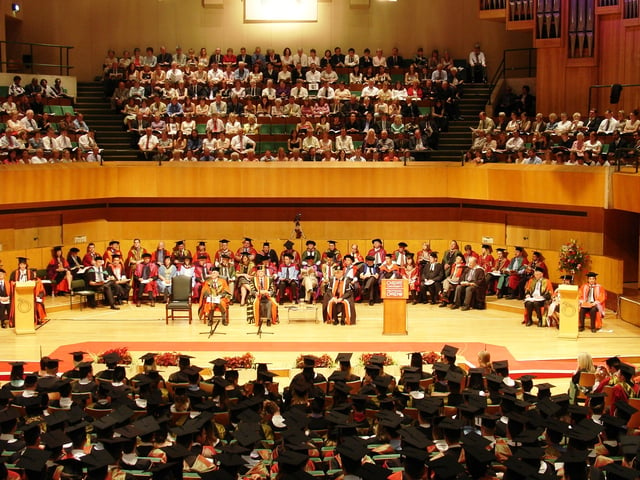
A Cardiff University graduation ceremony in 2006
In 1997, the college was granted full independent degree-awarding powers by the Privy Council, though, as a member of the University of Wales it could not begin using them, and in 1999 the public name of the university was changed to Cardiff University.
In 2002, ideas were floated to merge Cardiff again with the University of Wales College of Medicine, after publication of the Welsh Assembly Government's review of higher education in Wales. This merger became effective on 1 August 2004, when Cardiff University ceased to be a constituent of the University of Wales and became an independent "link institution" affiliated to the federal university. The process of the merger was completed on 1 December 2004, when the Act of Parliament transferring UWCM's assets to Cardiff University received Royal Assent. On 17 December it was announced that the Privy Council had given approval to the new Supplemental Charter and had granted university status to Cardiff, legally changing the name of the institution to Cardiff University. Cardiff awarded University of Wales degrees to students admitted before 2005, but these have been replaced by Cardiff degrees.
In 2005, Wales College of Medicine, as part of the University, launched the North Wales Clinical School in Wrexham, in collaboration with the North East Wales Institute of Higher Education in Wrexham, the University of Wales, Bangor, and the National Health Service in Wales. This received funds of £12.5 million from the Welsh Assembly[28] and trebled the number of trainee doctors in clinical training in Wales over a four-year period.
The university also has a popular Centre for Lifelong Learning, which has been teaching a wide range of courses for over 125 years.[29] However in July 2009, the University announced it was ending over 250 humanities courses at the centre, making over 100 staff redundant. The University has since reintroduced a number of humanities courses for a trial period beginning in 2010.[30]
In June 2010, the University launched three new research institutes,[31] each offering a new approach to a major modern research issue.
The Neurosciences and Mental Health Research Institute and the Cancer Stem Cell Research Institute are housed in the purpose-built Hadyn Ellis Building, and in the Sustainable Places Research Institute. Another part of the Science and Development Campus, the Cardiff University Brain Research Imaging Centre (CUBRIC), opened in June 2016 for neuroimaging research.[32]
Campus
Academic facilities
The University's academic facilities are centred around Cathays Park in central Cardiff,[33] which contains the University's grade II*listed main building,[34] housing administrative facilities and the science library;[35] the grade II listed Bute building,[36] which contains the Welsh School of Architecture[37] and the Cardiff School of Journalism, Media and Cultural Studies;[38] the grade I listed Glamorgan building,[39] which houses the Cardiff Schools of Planning and Geography and Social Sciences,[40] the Redwood Building (named in 1979 after the Redwood Family of Boverton near Llantwit Major by a 1978 suggestion by J. D. R. Thomas), which houses the School of Pharmacy and Pharmaceutical Sciences;[41] the law building which houses the Cardiff Law School;[42] and the biosciences building, which provides facilities for both biosciences and medical teaching.[43] The School of Engineering, School of Computer Science & Informatics and School of Physics and Astronomy are located in the Queen's Buildings, off Newport Road.
A number of University academic facilities are located at the Heath Park campus, based at the University Hospital of Wales. This contains the Cardiff University School of Medicine, the School of Dentistry, the School of Healthcare Sciences, and the School of Optometry and Vision Sciences.[44]
| Buildings of Cardiff University |
|---|
Athletics facilities
Most of the University's sports facilities are located at the sports training village in the Talybont Halls complex.
This includes facilities for football, badminton, basketball, tennis, hockey and gym.[45] Additional gym facilities and squash courts are located at the university fitness and squash centre, near the city centre campus at Cathays Park.[46] Extensive playing fields for Rugby, football and lacrosse are located at the University playing fields near Llanrumney.[47] The University also utilises the nearby Millennium Stadium for rugby fixtures such as the annual varsity tournament.[48]
Organisation
Schools and colleges
The 26 academic schools of the University are divided into three colleges: Arts, Humanities and Social Sciences; Biomedical and Life Sciences; and Physical Sciences.[49]
Cardiff also has a Doctoral Academy,[50] that brings together the work of four previous discipline-based Graduate Schools and the postgraduate research activity of the University's Graduate Centre.
Finances
In the financial year ended 31 July 2012, Cardiff University had a total net income of £425.54 million.[51] Key sources of income included £87.65 million from research grants and contracts, £117.36 million from Funding Council grants, £123.84 million from tuition fees and support grants and £3.17 million from endowment and investment income.[51] During the 2011/12 financial year Cardiff had a capital expenditure of £14.29 million.
At 31 July 2012 Cardiff had endowments of £25.58 million and total net assets of £402.86 million.[51]
Academic profile
Reputation and rankings
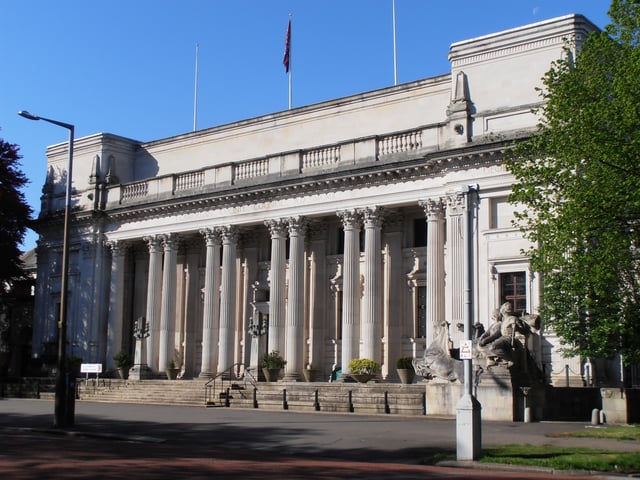
Glamorgan Building
Cardiff University continues the tradition of all three of its former institutions in providing high-quality research-based education in Wales, as shown in its five-year standing as the best centre of excellence in Wales in the Sunday Times League Tables, until 2017, where it was overtaken by Swansea University.
Cardiff is also the only university in Wales to be a member of the Russell Group of Research Intensive Universities. Cardiff is by far the strongest research-focused university in Wales. In the 2008 Research Assessment Exercise, 33 out of the 34 research areas submitted by the University for assessment were shown to be undertaking research that includes world-leading work.
Cardiff has two Nobel Laureates on its staff, Sir Martin Evans and Robert Huber.[59] A number of Cardiff University staff have been elected as Fellows of the Royal Society, these include Graham Hutchings FRS, professor of Physical Chemistry and Director of the Cardiff Catalysis Institute, School of Chemistry,[60] Ole Holger Petersen, MRC Professor and Director of Cardiff School of Biosciences.[61] and John M. Pearce, Professor of Psychology.[62]
In 2013, Cardiff University was ranked as one of the best UK universities for supporting LGB students, by the charity Stonewall in its annual Gay by Degree guide. The University was one of only two in the UK and the only one in Wales to achieve top marks in a Stonewall checklist of priorities for LGB students.[63]
Admissions
According to the 2017 Times and Sunday Times Good University Guide, approximately 15 per cent of Cardiff's undergraduates come from independent schools.[12] In the 2016–2017 academic year, the university had a domicile breakdown of 76:5:19 of UK:EU:non-EU students respectively with a female to male ratio of 59:41.[71]
Student life
Student accommodation
The University maintains 14 student halls and a number of student houses throughout the city of Cardiff; providing a total of 5,362 student places in accommodation.[72] They are in a variety of architectural styles and ages, from the Gothic Aberdare Hall, built in 1895, to the modern Talybont Halls, built in 1995. All first-year students are guaranteed a place in Halls.[73] The Cardiff University Halls are:
Aberconway Hall
Aberdare Hall
Cartwright Court
Colum Hall
Gordon Hall
Roy Jenkins Hall
Senghennydd Court
Senghennydd Hall
Talybont Halls
University Hall
Colum Road Houses
Student Village Houses
Students' Union
The Cardiff University Students' Union is a student-run organisation aiming to promote student interests within the University and further afield. The Cardiff University Students' Union building is near Cathays Park, next to Cathays railway station. It has shops, a night club and the studios of Xpress Radio and Gair Rhydd, the student newspaper. It is democratically controlled by the student body through the election of seven full-time officers, who manage the running of the Union.[74] The Union provides a range of services, including a number of cafes, bars and shops, as well as advice, training and representation. The Union is an affiliated member of the National Union of Students.[75]
Groups and societies
Media
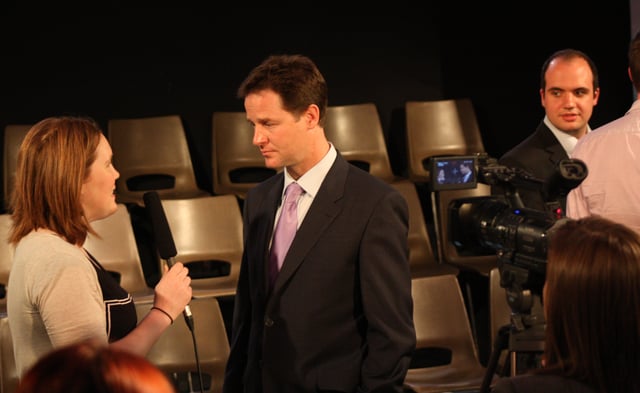
Nick Clegg at Cardiff University Students' Union conducting an interview with CUTV in 2010
The Union provides facilities and support for several student media groups, including: gair rhydd, an award-winning, free student newspaper that is released every Monday of term;[79] Quench, a monthly arts and lifestyle magazine that specialises in the local music scene as well as original investigative feature articles;[80] and CUTV, the student television channel.[81]
Xpress Radio is the student radio station. It broadcasts from 8 am to 1 am daily, with programming ranging from comedy panel shows and film review shows to new and local music showcases. It operates from a studio on the third floor of the Students' Union building.
Athletics
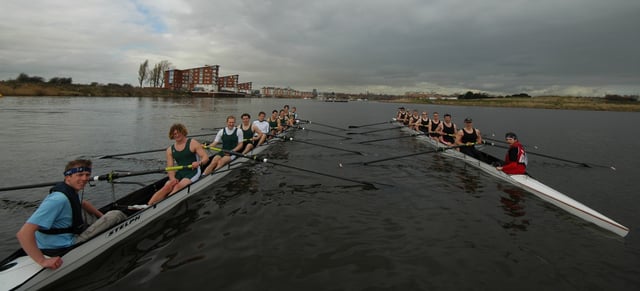
Swansea and Cardiff Universities Men's Senior eights during The Welsh Boat Race in 2006
The Cardiff University Athletic Union is the body that supports student sport at Cardiff, it oversees more than 60 competitive and non-competitive sports clubs, many of which compete in the British Universities and Colleges Sport league.[82] The University's Ice Hockey team, the Cardiff Redhawks (which also recruits players from other Welsh universities) competes in the British Universities Ice Hockey Association leagues.[83]
The university's sports teams also take part in the annual Welsh Varsity against Swansea University, which includes the Welsh Boat Race, and several other sporting competitions.[84] The Welsh Varsity rugby match has been described as "probably... the second biggest Varsity Game next to Oxford vs Cambridge".[85]
Cardiff participates in British Universities and Colleges Sport which manages a sporting framework of competitive fixtures and events for over 150 institutions around the UK.
Cardiff registers nearly 100 teams in the various leagues and competitions each year and sees students travelling around the country to represent Cardiff University.
In 2013 Cardiff team achieved 15th position overall across the 50 different sports hosting events.
Insignia and other representations
Motto
Coat of arms

Cardiff University's current coat of arms
Cardiff University's current coat of arms was granted by the College of Arms in 1988 following the merger of University College Cardiff and the University of Wales Institute of Science and Technology.[87] The coat of arms incorporates features from the heraldry of both former institutions. The three silver chevrons on a red background are derived from the arms of Iestyn ap Gwrgant, an 11th-century ruler of the Welsh Kingdom of Morgannwg that encompassed Glamorgan and Monmouthshire. The open book signifies learning; on it are the crescent and annulet, marks of cadence that indicate that University College Cardiff was the second of the University of Wales' institutions, and that the University of Wales Institute of Science and Technology was the fifth.[88]
A notable feature of the arms are the supporters, which in heraldry are rarely granted to universities. The supporters are an angel from University College Cardiff and a Welsh Dragon from the University of Wales Institute of Science and Technology. The crest is a Welsh dragon in the stance of a lion; it stands on the helmet. Both the dragon and the helmet are distinguished by being front-facing rather than in profile as is more usually found in Welsh heraldry.[88]
Notable alumni and faculty
Vice-Chancellors
List of Vice-Chancellors and Principals of Cardiff University and its predecessors (shown in brackets):
1883 to 1901 (University College of South Wales and Monmouthshire): John Viriamu Jones
1901 to 1918 (University College of South Wales and Monmouthshire): Ernest Howard Griffiths
1918 to 1929 (University College of South Wales and Monmouthshire): Professor A.H.
Trow
1929 to 1949 (University College of South Wales and Monmouthshire): Sir Frederick Rees
1949 to 1966 (University College of South Wales and Monmouthshire): Anthony Bedford Steel
1966 to 1972 (University College of South Wales and Monmouthshire): Dr CWL 'Bill' Bevan
1972 to 1987 (University College Cardiff): Dr CWL 'Bill' Bevan
1968 to 1988 (University of Wales Institute of Science and Technology): Sir Aubrey Trotman-Dickenson
1988 to 1993: Sir Aubrey Trotman-Dickenson
1993 to 2001: Sir Brian Smith
2001 to 2012: Sir David Grant
2012 to present: Professor Colin Riordan
Heads of state and government
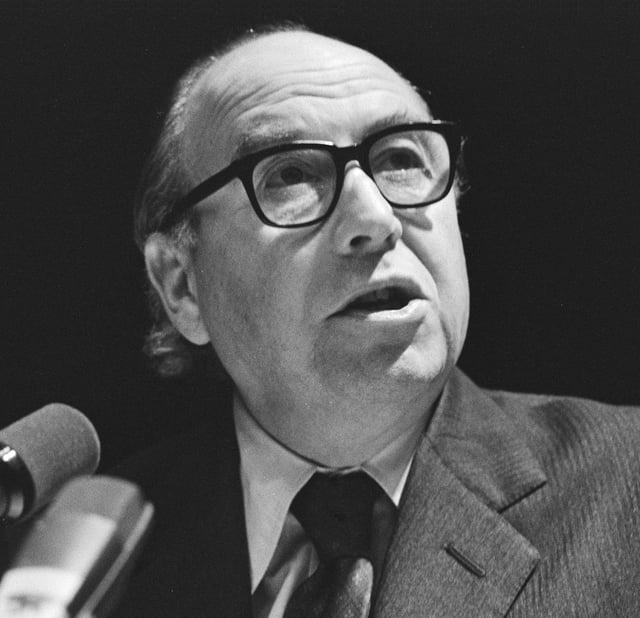
Roy Jenkins, former President of the European Commission
Lord Jenkins, former Chancellor of the Exchequer, Home Secretary, President of the European Commission and Chancellor of the University of Oxford (did not graduate)
Barham Salih, president of Iraq, former prime minister of the Iraqi Kurdistan Region and former deputy prime minister of the Iraqi federal government
Politics
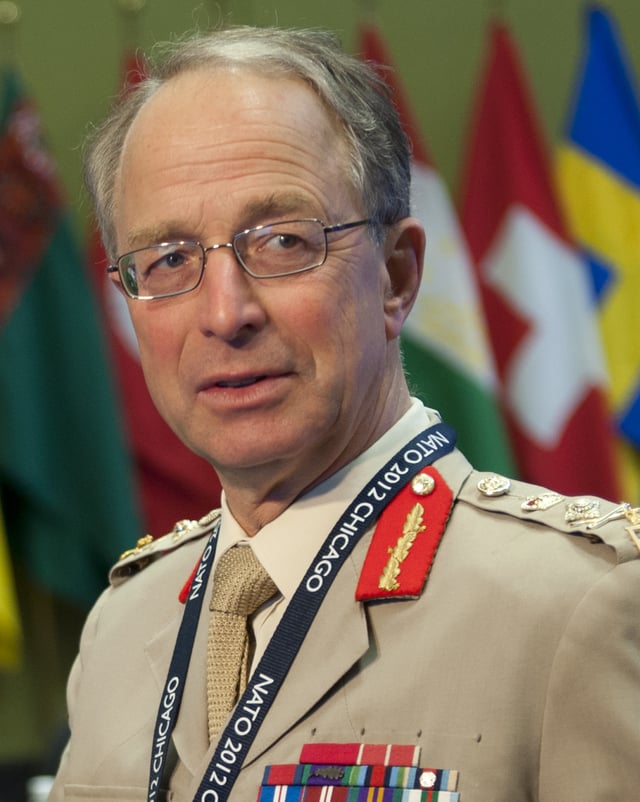
David Richards, Chief of the Defence Staff
David Bahati, current State Minister of Finance for Planning in the Uganda's Cabinet.
Christine Chapman, former AM for Cynon Valley
Jeffrey Cuthbert, Gwent Police and Crime Commissioner, former AM for Caerphilly and former Minister for Communities and Tackling Poverty
Hefin David, AM for Caerphilly
Wayne David, MP for Caerphilly and former Shadow Minister for Europe
Guto Harri, Communications Director for the Mayor of London Boris Johnson's administration at London City Hall
Elin Jones, AM for Ceredigion, current Presiding Officer and former Minister for Rural Affairs
Sir Emyr Jones Parry, former British Permanent Representative to the United Nations, (2003–2007[89])
Glenys Kinnock, former MEP and former UK Foreign Office Minister
Neil Kinnock, Leader of Her Majesty's Most Loyal Opposition (2 October 1983 – 18 July 1992)
Mike Hedges, AM for Swansea East
Hilary Marquand, former MP for Cardiff East
Robert Minhinnick, co-founder of Friends of the Earth (Cymru)[90]
Christopher Walter Monckton, 3rd Viscount Monckton of Brenchley, advisor to Margaret Thatcher
Craig Oliver, former Conservative Party Director of Communications
Bill Rammell, former MP for Harlow
David Rees, AM for Aberavon
Lord Richards, former Chief of the Defence Staff
Michael Shrimpton, barrister, politician, and conspiracy theorist
John Smith, former MP for the Vale of Glamorgan, former member of the Defence Select Committee.
Brian Wilson, former MP for Cunninghame North
Mike Wood, Member of Parliament for Dudley South
Academia
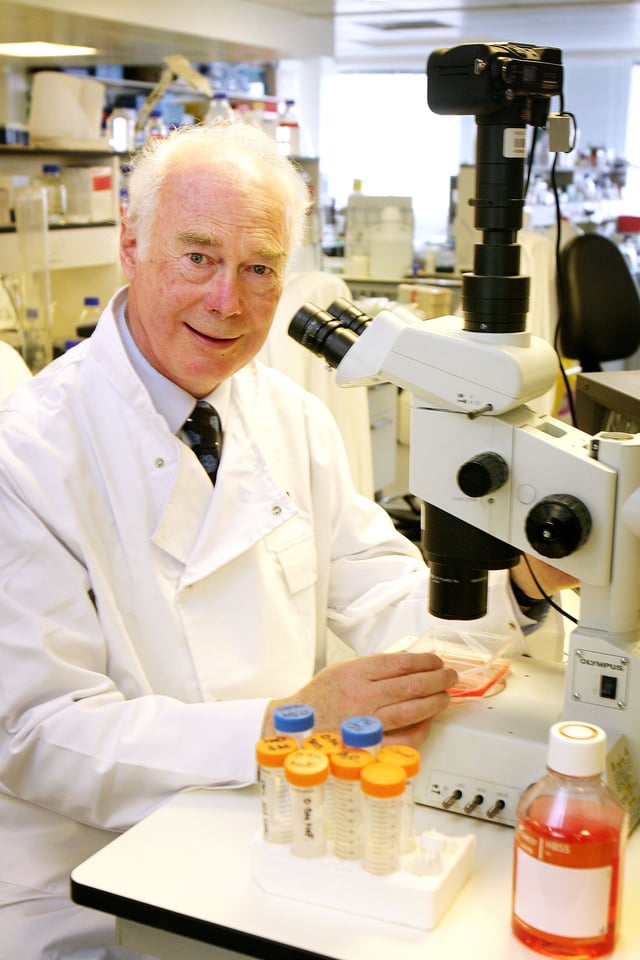
Martin Evans, Nobel Laureate in Physiology or Medicine
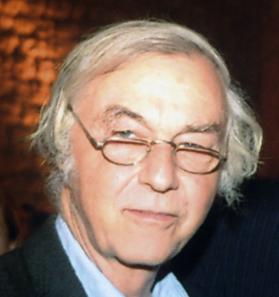
Robert Huber, Nobel Laureate in Chemistry
Miguel Alcubierre, Mexican theoretical physicist
Rudolf K. Allemann, Swiss biochemist
Robin Attfield, philosopher
Martin J. Ball, Professor of Speech Language Pathology at Linköping University, Sweden
Yehuda Bauer, Professor of Holocaust Studies at the Avraham Harman Institute of Contemporary Jewry at the Hebrew University of Jerusalem
Leszek Borysiewicz, Vice-Chancellor of the University of Cambridge
The Rt Revd Gregory Cameron, Bishop of St Asaph
Sheila Cameron QC, lawyer and ecclesiastical judge
Archie Cochrane, pioneer of scientific method in medicine
Peter Coles, Professor of Astrophysics
The Rt Revd Paul Colton, Bishop of Cork, Cloyne and Ross
David Crouch, historian
Alun Davies, bioscientist
Huw Dixon, economist
Stephen Dunnett, neuroscientist
Sir Martin Evans, Nobel Prize for Medicine[91] 2007
Dimitra Fimi, writer
Karen Holford, engineer
Robert Huber, Professor of Chemistry, Nobel Laureate – The Nobel Prize in Chemistry 1988[92][93]
John Loughlin, Professor of Politics
Vaughan Lowe QC, (Chichele Professor of Public International Law in the University of Oxford
Patrick Minford, Professor of Applied Economics
John Warwick Montgomery – American lawyer and theologian; Distinguished Research Professor of Philosophy and Christian Thought at Patrick Henry College.[94]
Christopher Norris, literary critic
Sir Keith Peters, FRS PMedSci (Regius Professor of Physic in the University of Cambridge)
Leighton Durham Reynolds, Emeritus Professor of Classical Languages and Literature, University of Oxford
Alice Roberts, clinical anatomist and osteoarchaeologist
Wendy Sadler, physicist and science communicator
H. W. Lloyd Tanner, Professor of Mathematics and Astronomy (1883–1909)
Pamela Taylor, Professor of Forensic Psychiatry since 2004
Meena Upadhyaya, medical geneticist
The Rt Revd Dominic Walker, OGS, Bishop of Monmouth
Keith Ward, philosopher, Gresham Professor of Divinity, Gresham College
Chandra Wickramasinghe, Professor of Applied Mathematics
Rheinallt Nantlais Williams, academic
Business
Spencer Dale, Chief economist, Bank of England
Andrew Gould, Chairman and former CEO, Schlumberger[95]
Martin Lewis, personal finance journalist, television presenter and website entrepreneur
Dame Mary Perkins, Co-Founder, Specsavers
Ceri Powell, senior Royal Dutch Shell executive
John Pettigrew (businessman), CEO, National Grid plc
Sport
Nathan Cleverly, professional boxer and former WBO light heavyweight world champion
Gareth Davies, former Wales and British and Irish Lions international rugby union player, and current chief executive of Cardiff Rugby Football Club
Gerald Davies, former Wales and British and Irish Lions international rugby union player
Mike Hall, former Wales and British and Irish Lions international rugby union player
Steven Outerbridge, Bermudian cricketer
Jamie Roberts, Wales and British and Irish Lions international rugby union player
James Tomlinson, English cricketer
Bradley Wadlan, Welsh cricketer
Alex Gough, Squash player
Arts and journalism
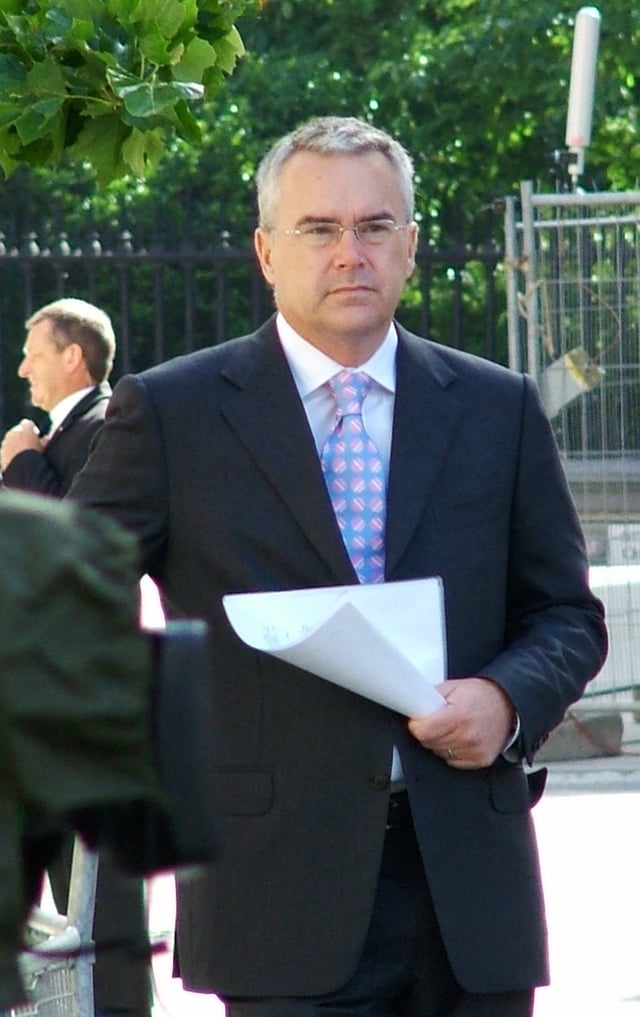
Huw Edwards, BAFTA award-winning journalist
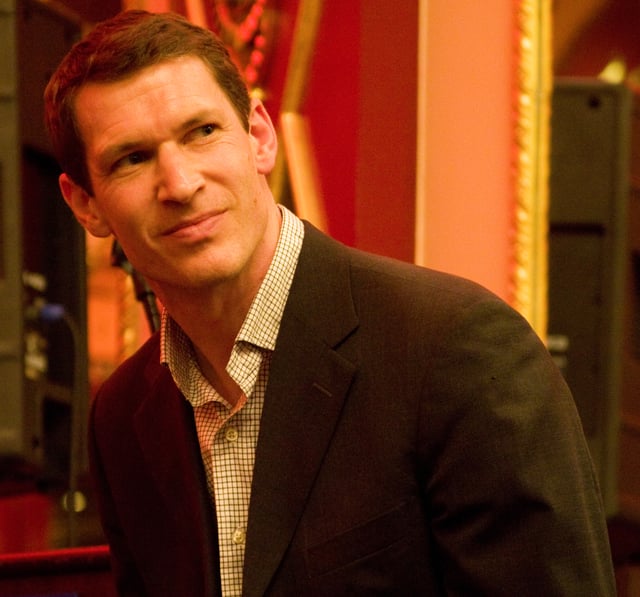
Tim Hetherington, nominee of the Academy Award for Best Documentary Feature in 2011
Paul Atherton, television and film producer and director
Matt Barbet, journalist
Manish Bhasin, journalist and television presenter
Nick Broomfield, documentary filmmaker and receiver of the BAFTA Lifetime Achievement Award for Contribution to Documentary
Philip Cashian, composer
Suw Charman-Anderson, journalist and social software consultant.
Adrian Chiles, television presenter
Gillian Clarke, poet and receiver of the Queen's Gold Medal for Poetry
Huw Edwards, journalist
Ken Elias, artist/painter
Max Foster, CNN Anchor, CNN Today[96]
M. A. Griffiths, poet
Julia Hartley-Brewer, journalist and television presenter
Jiang Heping, Executive Director of the CCTV Sports Programming Centre and Controller of CCTV-5
Tim Hetherington, photo-journalist and co-director of Academy Award-nominated Restrepo
Elis James, stand up comedian and actor
Alun Hoddinott, composer
Sioned James (1974-2016), choral conductor
Karl Jenkins, composer
Alan Johnston, journalist
Riz Khan, journalist and television interviewer
Bernard Knight, crime writer
Simon Lane, co-founder and Creative director of The Yogscast Ltd
Gwilym Lee, actor.
Siân Lloyd, television presenter
Los Campesinos!, six piece indie pop band
Philip Madoc, actor
Paul Moorcraft, writer
Sharon Morgan, actress
Joanna Natasegara, documentary producer, Academy Award winner for Netflix documentary The White Helmets
Siân Phillips, actress
Susanna Reid, television presenter
James Righton, musician
Arlene Sierra, composer
Mari Strachan, novelist and librarian
Richard Tait, former BBC Governor and BBC trustee
Craig Thomas, author
Vedhicka, Indian actress
Grace Williams, composer
Ron Smerczak actor[97]
Ibrahim Sheme. Nigerian journalist, novelist, publisher
See also
List of universities in Wales
List of modern universities in Europe (1801–1945)
Education in Wales
Town and gown
